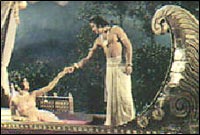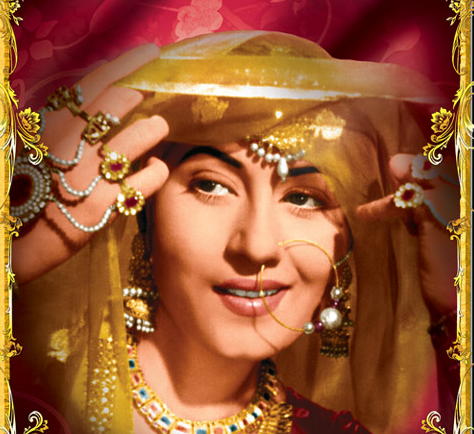Amma! Pakoda!
Mummy! Fried fritters!
These are the iconic words of a rotund boy on a bus who craves the fried fritters that another rider is eating. The film is Bombay to Goa (1972), and the salivating boy, his fritter-munching fellow-traveller and many other colourful characters are (you guessed it) on a bus going from Bombay to Goa. The boy is oddly dressed for a Bollywood flick: he wears a sacred thread across his bare chest, which marks him as a Brahmin; he has three lines of ash smeared across his forehead, which marks him as coming from a devout Shiva-worshipping family; and he wears a white sarong and sports a peculiar Hindi accent, both of which mark him out as a South Indian -- often generically called a 'Madrasi' after the South Indian city of Madras (now Chennai). There's another thing that marks him as a South Indian -- he's a buffoon.
The character of the Madrasi buffoon is quite popular in Bollywood cinema. The buffoon in the film Bombay to Goa is quite a caricature, but considering that this bus-trip film is brimming over with ethnic stereotypes, his buffoonery is only marginally more noticeable than the antics of the film's other characters.
The film best known for it's Madrasi Buffoon is Padosan (1968). This film features the memorable character of Master Pillai, a teacher of South Indian classical music and dance (played by Mahmood, who seems to be the master of South Indian buffoonery). Master Pillai is in love with his student, Bindu (played by Saira Banu), who is a sassy, sophisticated (North Indian) city girl. Bhola, a North Indian country hick of a neighbour, is also in love with Bindu. Wanting to get back at Bhola for his audacity, Bindu uses Master Pillai as her battering ram. The two men face-off in a song that has now become an all-time Bollywood classic ik chatur naar [The clever woman] (rendered to perfection by Manna Dey and Kishore Kumar). In the end, Bhola is victorious in this battle of songs, leaving Bindu infuriated and Master Pillai humiliated.
It's easy to dismiss the character of the Madrasi Buffoon as merely a gross ethnic stereotype, which it is. But there is also a certain poignancy that goes with this stock character. He is, by necessity or by contrivance, an outcast in the North Indian milieu that is the Bollywood film. He (it's usually a man) is swarthy, ungainly or crude, and his spoken Hindi (not his native tongue) leaves much to be desired. He is clearly a foil for the urbane, refined, and fair-skinned hero (the bias against dark skin in Indian cinema may have to be another posting). His naiveté is disarming, his crude attempts at romance are endearing, and the discerning eye may catch glimpses of a deeper, more complex personality under the veneer of buffoonery; but he never truly gets past his Otherness.
Over the past two decades South Indians in North Indian-dominated Bollywood have responded in a very striking, yet subtle way to this ethnic caricature in Bollywood cinema; not by fighting it, but by getting the caricature right. That is, these caricatures are not what North Indians imagine South Indians to be; instead, they are aspects of South Indian life and culture that we, as South Indians, enjoy mocking ourselves. The earliest form of this I could dig up was this scene by Sridevi (a true Madrasi herself) in the film Roop ki Rani Choron ka Raja (1993), in which she embodies all the melodrama and histrionics that is so characteristic of classic South Indian cinema. Another star of this 'meta' genre is Channel [V]'s Lola Kutty. A Malayalee off-screen as well as on, Lola is the unlikely host of a Bollywood talk show. Decked out in fine South Indian silks, sporting the characteristic garland of jasmine in her hair, and armed with a swarthy, mustachioed sidekick in a sarong, Lola accosts her Bollywood guests with clever banter in Hindi and English that is unabashedly dripping with a Malayalee accent. In my view, the recent film Quick Gun Murugun (2009) is a masterful sendup in this genre: as a kitschy sambhar-Western, it spoofs South Indian Cinema, but also shows Bollywood how it's really done.
Tadka Dal
When confronted with the curly-haired, knee-baring, sarong-wearing, coconut-eating, swarthy folk of southern India, the North Indian is left baffled. Unable to reconcile the fact that the 'Madrasi' too is a fellow-Indian, the North Indian settles on the notion that he must be a joke.
Source
Volumes may be written on the great North Indian/South Indian divide. There are clear cultural differences across the diverse peoples that inhabit the Indian subcontinent, but none is rendered so stark as that between the North and the South. Some trace the mutual distrust and shock at the other's ways as far back as the 25th century BCE when the Aryan peoples of the steppes began their migration to the Subcontinent, which was already inhabited by Dravidian groups. I have heard it said that in the great Indian epic Ramayana, the kingdom of monkey-men that prince Ram comes upon on his way south to Lanka was in fact his encounter with South Indians! The tension between North and South is perhaps as racial as it is cultural, but in India these conversations (and caricatures) are rarely framed in terms of race.
The political structures of the sub-continent and the shifting centres of power over the past 300 years or more have also affected the North/South dynamic: many of the vast dynasties of medieval India were centered in the North Indian plains; the British too focused much of their early attentions on East and North India; perhaps consequently, (re)constructions of Indian histories in the colonial era were weighted towards the North; and the Partition of India and the creation of Pakistan also shifted much of national and international political attention to North India.
Mummy! Fried fritters!
These are the iconic words of a rotund boy on a bus who craves the fried fritters that another rider is eating. The film is Bombay to Goa (1972), and the salivating boy, his fritter-munching fellow-traveller and many other colourful characters are (you guessed it) on a bus going from Bombay to Goa. The boy is oddly dressed for a Bollywood flick: he wears a sacred thread across his bare chest, which marks him as a Brahmin; he has three lines of ash smeared across his forehead, which marks him as coming from a devout Shiva-worshipping family; and he wears a white sarong and sports a peculiar Hindi accent, both of which mark him out as a South Indian -- often generically called a 'Madrasi' after the South Indian city of Madras (now Chennai). There's another thing that marks him as a South Indian -- he's a buffoon.
The character of the Madrasi buffoon is quite popular in Bollywood cinema. The buffoon in the film Bombay to Goa is quite a caricature, but considering that this bus-trip film is brimming over with ethnic stereotypes, his buffoonery is only marginally more noticeable than the antics of the film's other characters.
The film best known for it's Madrasi Buffoon is Padosan (1968). This film features the memorable character of Master Pillai, a teacher of South Indian classical music and dance (played by Mahmood, who seems to be the master of South Indian buffoonery). Master Pillai is in love with his student, Bindu (played by Saira Banu), who is a sassy, sophisticated (North Indian) city girl. Bhola, a North Indian country hick of a neighbour, is also in love with Bindu. Wanting to get back at Bhola for his audacity, Bindu uses Master Pillai as her battering ram. The two men face-off in a song that has now become an all-time Bollywood classic ik chatur naar [The clever woman] (rendered to perfection by Manna Dey and Kishore Kumar). In the end, Bhola is victorious in this battle of songs, leaving Bindu infuriated and Master Pillai humiliated.
It's easy to dismiss the character of the Madrasi Buffoon as merely a gross ethnic stereotype, which it is. But there is also a certain poignancy that goes with this stock character. He is, by necessity or by contrivance, an outcast in the North Indian milieu that is the Bollywood film. He (it's usually a man) is swarthy, ungainly or crude, and his spoken Hindi (not his native tongue) leaves much to be desired. He is clearly a foil for the urbane, refined, and fair-skinned hero (the bias against dark skin in Indian cinema may have to be another posting). His naiveté is disarming, his crude attempts at romance are endearing, and the discerning eye may catch glimpses of a deeper, more complex personality under the veneer of buffoonery; but he never truly gets past his Otherness.
Over the past two decades South Indians in North Indian-dominated Bollywood have responded in a very striking, yet subtle way to this ethnic caricature in Bollywood cinema; not by fighting it, but by getting the caricature right. That is, these caricatures are not what North Indians imagine South Indians to be; instead, they are aspects of South Indian life and culture that we, as South Indians, enjoy mocking ourselves. The earliest form of this I could dig up was this scene by Sridevi (a true Madrasi herself) in the film Roop ki Rani Choron ka Raja (1993), in which she embodies all the melodrama and histrionics that is so characteristic of classic South Indian cinema. Another star of this 'meta' genre is Channel [V]'s Lola Kutty. A Malayalee off-screen as well as on, Lola is the unlikely host of a Bollywood talk show. Decked out in fine South Indian silks, sporting the characteristic garland of jasmine in her hair, and armed with a swarthy, mustachioed sidekick in a sarong, Lola accosts her Bollywood guests with clever banter in Hindi and English that is unabashedly dripping with a Malayalee accent. In my view, the recent film Quick Gun Murugun (2009) is a masterful sendup in this genre: as a kitschy sambhar-Western, it spoofs South Indian Cinema, but also shows Bollywood how it's really done.
Tadka Dal
When confronted with the curly-haired, knee-baring, sarong-wearing, coconut-eating, swarthy folk of southern India, the North Indian is left baffled. Unable to reconcile the fact that the 'Madrasi' too is a fellow-Indian, the North Indian settles on the notion that he must be a joke.
Source
Volumes may be written on the great North Indian/South Indian divide. There are clear cultural differences across the diverse peoples that inhabit the Indian subcontinent, but none is rendered so stark as that between the North and the South. Some trace the mutual distrust and shock at the other's ways as far back as the 25th century BCE when the Aryan peoples of the steppes began their migration to the Subcontinent, which was already inhabited by Dravidian groups. I have heard it said that in the great Indian epic Ramayana, the kingdom of monkey-men that prince Ram comes upon on his way south to Lanka was in fact his encounter with South Indians! The tension between North and South is perhaps as racial as it is cultural, but in India these conversations (and caricatures) are rarely framed in terms of race.
The political structures of the sub-continent and the shifting centres of power over the past 300 years or more have also affected the North/South dynamic: many of the vast dynasties of medieval India were centered in the North Indian plains; the British too focused much of their early attentions on East and North India; perhaps consequently, (re)constructions of Indian histories in the colonial era were weighted towards the North; and the Partition of India and the creation of Pakistan also shifted much of national and international political attention to North India.









